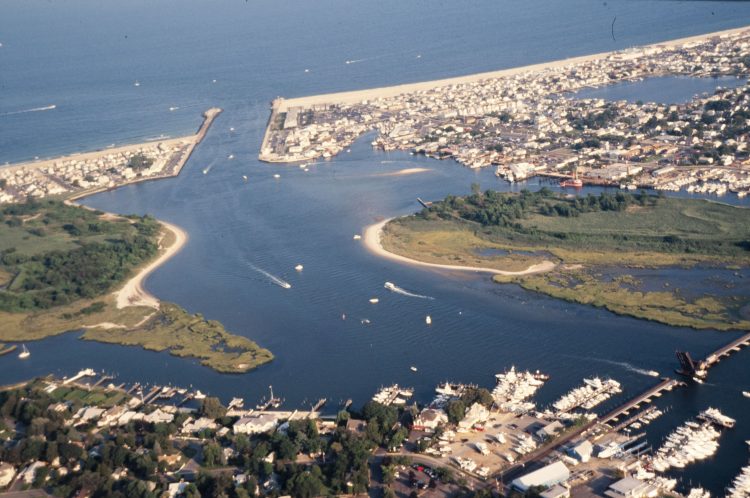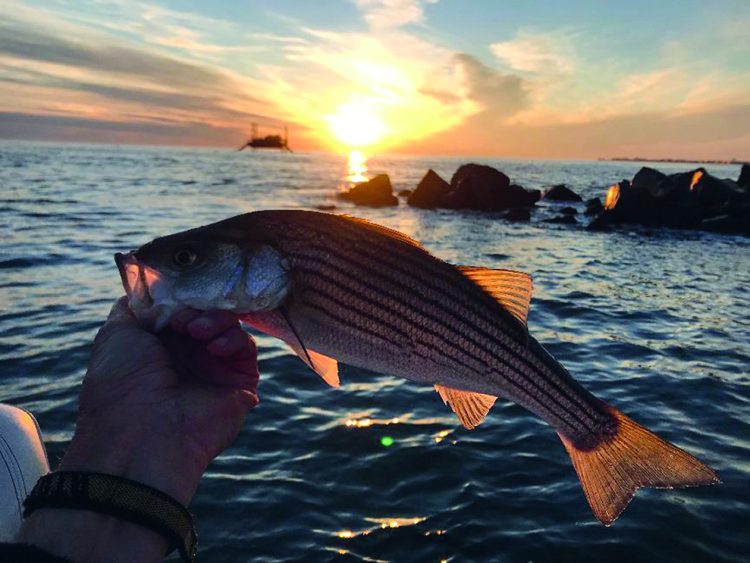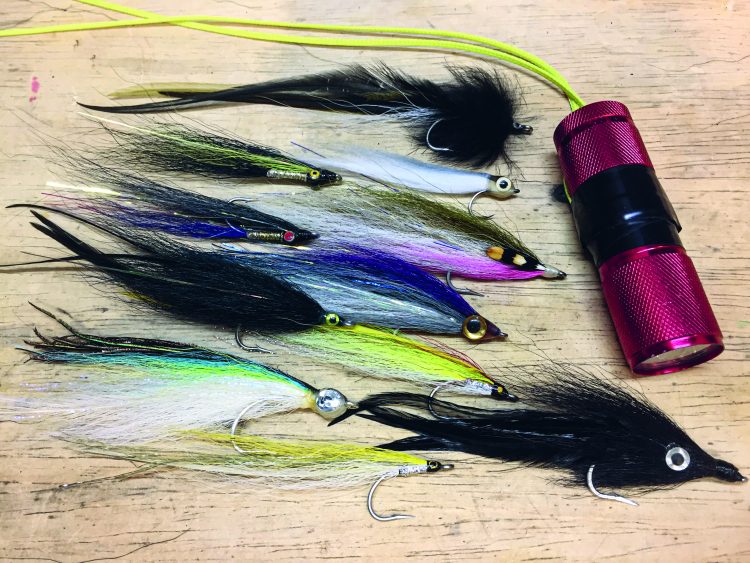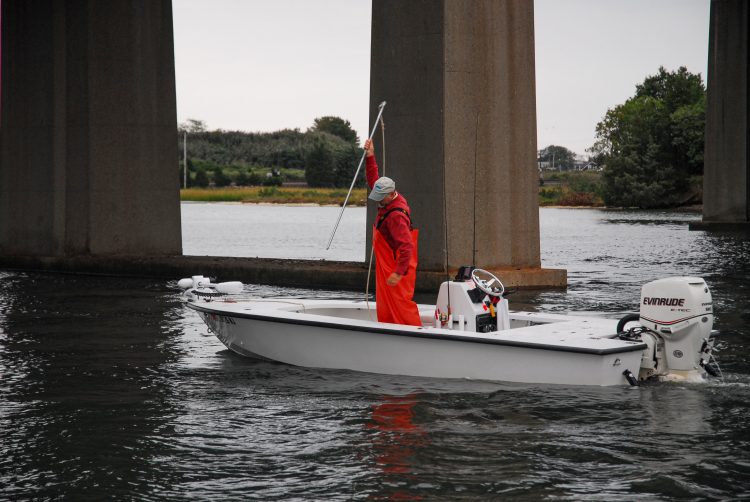Coastal Inlets: Striped Bass Magnets
Inlets feature various types of hard and soft structure that host a plethora of baitfish species for striped bass and other predators to enjoy.

There are no guarantees in fishing and that’s partly what makes fly fishing so appealing. Its great attraction lies in the combination of anticipating what might happen and then what actually does happen. Members of the fly-fishing clan with a philosophical bent talk about the joy of making a really good cast or their appreciation of a colorful sunrise, but without the reward of a fish or two to sweeten the experience, enthusiasm fades away. As the end of another season approaches, it’s time to concentrate on fishing those places that get us tight to as many fish as possible, stockpiling happy memories. Some of the best and most predictable choices for good fly-fishing opportunities will be found at coastal inlets.
Depending on where you live, they may be called by different names. From Montauk to the Outer Banks, they’re usually called inlets while New Englanders know them as breachways. In Florida, they may be called inlets or passes. On Martha’s Vineyard, temporary manmade openings to drain salt ponds are called cuts. No matter what you call them they all have common characteristics and offer excellent fly-fishing opportunities at the end of the summer and into early fall.
The exchange of ocean water with back-bay water, the strong and predictable currents, and a variety of fish-holding structure draws impressive concentrations of bait and therefore a steady supply of hungry gamefish. While the striped bass is king, weakfish, bluefish, and fluke also take up residence, and little tunny (albies) often crash the party. One crazy morning, albies ran through Manasquan Inlet all the way to Hoffman’s Marina by the railroad bridge. Same thing may happen at Long Island’s Rockaway and Shinnecock Inlets, and Rhode Island’s Charlestown Breachway. Inlets can be full of pleasant surprises.

Inlets are the direct connection between the ocean and back-bay creeks, marshes, and channels. The amount of bait that flows into and out of inlets can be astonishing, and not only fish baits like peanut and adult bunker, spearing, silversides, and mullet but also crabs and squid. To striped bass, inlets are like a visit to Mel’s Diner—everything’s on the menu.

Besides the ready bait supply, there are several additional bonuses. Inlets are relatively small in size compared to miles of open beaches or open ocean so the fish are concentrated. Inlets are either manmade with huge jetty rocks or interlocking dolos concrete structures to channel water and break up the waves when storms assault the coast. Or, they are natural sandy openings like cuts, bars, and shoals like those found at Beach Haven and Oregon Inlet that constantly change and have no desire to remain stable or predictable. Natural inlets change quite a bit from year to year and shoals often build into an island only to disappear weeks later in a storm or as prevailing winds carry away (or add) sand.
Manmade inlets are stable and don’t change much from season to season while natural inlets are in a state of constant flux, always changing. Some natural inlets are navigable, some aren’t, and some are stalked by kayak and small boats with shallow drafts.
Inlets with jetties often boast easy access and safe parking, which can be a joy or a curse. At night, there is little crowding from fellow flyrodders, but once the sun is up, it’s a different story. Inlet jetties also attract tourists, joggers, dog walkers, and bench sitters. With diminishing elbow room, jetties can be just too crowded to fish effectively or safely during the day.
Because success at inlets depends so much on fishing a moving current, all you need is a tide table to figure out the best time to go. Stop at the local bait shop for a tide table or look up the info online. There is never a guarantee in any kind of fishing, but inlets are a pretty sure bet.
Every inlet has its own personality and unique quirks and structure. Besides the obvious manmade jetty structure like rocks, inlets also have deep holes at the ocean-side mouth and at the end of the jetty where it opens to a back bay or river. There may be sandy shoals, deep pockets, merging channels, a salt marsh, a bridge or two, boulder fields, and shellfish beds. All can hold fish and there’s often a rhythm the fish follow when they move from one structure to another as the tide ebbs and flows.
The mouth of an inlet, where it meets the ocean, is always a good bet. It can be fished from the top of the jetty by making casts in a fanlike pattern that covers all the territory and maybe even a boulder field at the tip. Many fly anglers focus on casting toward the deep-channel side of the inlet but boat traffic, day and night, can make this a difficult plan of attack. Most of the fish are close to the rocks, so distance casts are rarely needed. The beach side of an inlet jetty can also be excellent, especially the so-called pocket where the jetty meets the sandy beach. Bait often hold in the swirling currents caused by the incoming and receding waves and sometimes in massive quantities. The pocket can be fished from the rocks or from the beach.
The throat or midsection of an inlet is usually the narrowest section, which speeds up the current and making it tough to work a fly. There may also be a local population of gawkers and coffee-sippers as they watch the sunrise, as at Manasquan and Shark River inlets, while the inlets at Montauk, Rockaway, and Delaware’s little Roosevelt are much more fly-caster friendly. Casts to the edge of the rocks that allow the fly to swing in the current are usually more productive rather than trying for long-range casts across the inlet unless you see fish breaking. At Montauk one morning, a mix of blues and albies created a feeding station near the last quarter of the east jetty, crashing bait and paying no attention to the steady stream of outgoing boat traffic.
Work the fly right to the rocks, rod tip down toward the water. Many strikes will occur just as the fly is lifting toward the surface on the last 20 feet of the retrieve. Integrated sink-tip lines, either intermediate or heavyweight 350 grains, are a good choice to get a fly deep toward the rocks and to overcome the lifting power of the swift current.
The deep, swirling pockets that usually form just inside an inlet offer interesting fly-fishing opportunities and gamefish often linger in these areas through the entire tide. The currents on an incoming tide can be like whirlpools that stir up a delicious baitfish stew. They scour the bottom into a deep depression, a perfect spot for gamefish to lie in wait. Just as at the mouth of the inlet and the midway areas, the inside pockets may require a sinking or sink-tip line to get down to where the fish are feeding. Other times, though, striped bass or bluefish may cause quite a commotion on the surface as they feed on rain bait, sand eels, mullet, and peanut bunker right on the surface. In such an instance, a floating line is the better choice.
Traveling further up a river and deeper into the estuary, the back sides of an inlet will often have a mix of sandy shoals, mussel and shellfish beds, perhaps some marsh banks, and maybe a field of rocks and gravel bars. As an example, the Manasquan River Inlet begins in the traditional manmade way with a pair of jetties at its opening to the sea, then transitions into the throat at its midsection. The jetties end at the deep holes at the back side of the inlet. Moving upriver, there’s a sandy flat on the north side, then a salt creek, marsh, and muddy tidal pond, while across the river to the south, there’s a broad, sandy shoal and a spoil island that boasts a short creek and a beautiful marsh.
Areas like these make fly fishing inside an inlet great places for wading, depending on the bottom. Soft muck is terribly hard to wade. I once got my wader boots stuck so much in a shallow spot that I had to get down on all fours and crawl to nearby hard bottom. Ruined the night with waders full of water and stinky marsh mud.
It always amazes me that so much backside inlet water is overlooked and only a handful of local fly anglers fish it. That is a blessing because these backcountry areas are much less crowded. Anyone dedicated enough to fish these spots by beaching a kayak or walking a tangled path to the river and wading through an evening tide will quickly find out where the good spots are. A casual fly angler making a one-time visit and not committing a sincere attempt to learn the structure and the best tide stages may get lucky and catch a fish, but it takes effort to score trip after trip.
Nearby bridges add immeasurably to the potential of back country inside an inlet. It may be a well-worn cliché but it’s true that bridges attract enormous pods of bait and host a reliable supply of striped bass and other gamefish. An incoming tide can be okay, but the dropping tide is usually the better bet because more food washes out from the upcurrent marshes. A small skiff with an electric motor that has a “Spot-Lock” feature is a great help to maintain position, or you can anchor. Kayakers often employ a simple anchor trolley to keep in position using a mushroom anchor. Some areas near bridges have soft bottom, so either mud or spongy colonies of mussels and a spear anchor is a great tool to hold a skiff, kayak, or canoe steady against the current. A spear anchor is quick to deploy and holds with amazing firmness.

Daytime fishing in an inlet channel with bait or leadhead bugs is standard procedure for a good catch of fluke, sea bass, and weakfish, but nighttime fly rodding is a lot safer if you avoid the channels. Big boats can’t see you, even with a bright white nav light. Fish the shallows and the high edges of channels where the big boats can’t mess with you because they’d run aground. Channels spanned by low bridges are also good choices.
One more word about sinking lines. Some of the best inlet fishing is on the edges of structure: jetty rocks, a drop-off into a channel, a sloping shoal so a sinking line is the best choice. It’s probably shallow if you’re wading, but where you’re casting may be several feet deep. Many inlet sharpies rely on an intermediate or a Type-3 sink-tip. One last suggestion is that you don’t always have to wade deep. Sometimes, distance is essential; other times, the fish are right at your feet close to shore. Work the close-in water before launching those long-range casts.
Catch ‘em up!
Leave a Reply